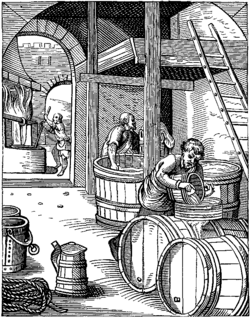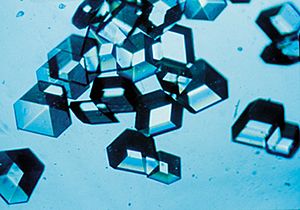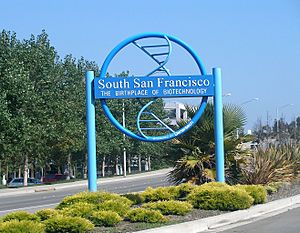History of biotechnology facts for kids
Biotechnology uses science and engineering to change materials using living things. This helps create useful products and services. For a long time, biotechnology has been closely connected to society. Today, we often think of it for making medicines. But in the past, it was mostly about food, helping with problems like not having enough to eat or widespread hunger.
The story of biotechnology began with zymotechnology. This field first focused on how to make beer. By World War I, zymotechnology grew to solve bigger industrial problems. The power of using living things to create products led to the term "biotechnology." However, some early projects, like making food from single cells or special fuel, didn't work out. This was due to things like people not wanting them, changes in the economy, and shifts in government power.
Later, a new area called genetic engineering made biotechnology very important in science and society. This led to close discussions between scientists, the public, and the government. These talks became well-known at the Asilomar Conference in 1975. Joshua Lederberg was a strong supporter of this new field. By 1978, his ideas proved right when scientists created man-made human insulin. The biotechnology industry then grew very quickly. Every new scientific step became big news, aiming to get public support. By the 1980s, biotechnology became a real and promising industry. In 1988, only five proteins made from genetically engineered cells were approved as medicines in the U.S. But by the end of the 1990s, this number jumped to over 125.
Today, genetic engineering is still a hot topic. This is because of new developments like gene therapy, stem cell research, cloning, and genetically modified food. It seems normal now to think of medicines as solutions to health problems. But this idea of biotechnology helping society started many centuries ago.
Contents
How did biotechnology begin?
Biotechnology grew from zymotechnology, which was also called zymurgy. This field started by trying to better understand how to make things through fermentation, especially beer. Beer was important for industry, not just for fun. In the late 1800s in Germany, making beer contributed as much to the country's economy as making steel. Taxes on alcohol also brought a lot of money to the government.
In the 1860s, special schools and businesses focused on brewing technology. The most famous was the Carlsberg Institute, started in 1875. There, Emil Christian Hansen found a way to use pure yeast. This helped make beer that was always the same quality. Other private companies also advised brewers. One of these was the Zymotechnic Institute in Chicago, started by chemist John Ewald Siebel.
Biotechnology during World War I
Zymotechnology became very popular and grew during World War I. This was because industries needed support for the war. Max Delbrück grew huge amounts of yeast during the war. This helped meet 60 percent of Germany's animal feed needs. Other products from fermentation, like lactic acid, were used to make up for a lack of hydraulic fluid. On the Allied side, Russian chemist Chaim Weizmann used starch to solve Britain's shortage of acetone. Acetone was a key material for making explosives. He did this by fermenting corn to get acetone.
The industrial power of fermentation was growing beyond just brewing. Soon, "zymotechnology" changed to "biotechnology."
The word "biotechnology" is born
With food shortages and fewer resources, some people dreamed of a new industrial solution. In 1919, a Hungarian man named Károly Ereky created the word "biotechnology." He used it to describe a way of turning raw materials into more useful products. He built a huge farm and slaughterhouse that raised over 100,000 pigs a year. It became one of the biggest and most profitable meat businesses in the world.
In his book Biotechnologie, Ereky wrote about an idea that would be repeated throughout the 20th century. He believed biotechnology could solve big problems like food and energy shortages. For Ereky, "biotechnologie" meant using living things to improve raw materials into products useful for society.
This new word quickly spread after World War I. "Biotechnology" appeared in German dictionaries and was used by businesses in other countries, even in the United States. For example, in Chicago, when alcohol was banned (Prohibition) after World War I, biological industries looked for new ways to make money. They focused on new fermented products, especially non-alcoholic drinks. Emil Siebel, whose father founded the Zymotechnic Institute, started his own company called the "Bureau of Biotechnology." It offered special knowledge in making fermented non-alcoholic drinks.
New medicines from biotechnology
The idea that industrial society's needs could be met by fermenting farm waste was important. Fermentation processes created more and more useful products. In the 1940s, penicillin was the most amazing example. It was found in England but made in large amounts in the U.S. using a special fermentation process. The huge profits and public hope from penicillin greatly changed the medicine industry. Doctors called it a "miracle drug."
Starting in the 1950s, fermentation technology also became good enough to make steroids in large amounts. An important improvement was making cortisone in fewer steps. This reduced the cost of the medicine by 70%, making it cheap and available. Even today, biotechnology is key to making these compounds and will likely be for many years.
Early challenges for biotechnology
Even bigger hopes for biotechnology came in the 1960s with a process that grew single-cell protein. When a "protein gap" threatened world hunger, making food locally from waste seemed like a solution. Scientists, leaders, and businesses were excited about growing tiny living things on oil. Big companies like British Petroleum (BP) put their future on it. In 1962, BP built a test factory in France to show off its product, Toprina.
In 1966, the term "single-cell protein" (SCP) was created at MIT. This gave the new foods an acceptable and exciting name, avoiding words like "microbial" or "bacterial."
Why single-cell protein didn't work out
The "food from oil" idea became popular by the 1970s. Factories for growing yeast fed by oil were built in many countries. The Soviets were especially keen, opening large "protein-vitamin concentrate" plants near their oil refineries.
However, by the late 1970s, things had changed. The cost of oil went up five times in 1974. Also, even with hunger around the world, the demand for this food shifted from humans to animals. The program started to feed people in poorer countries. But the product was launched as animal food for richer countries. The rising demand for animal feed made that market seem more profitable.
But the main reason the SCP project failed was public resistance. This was especially strong in Japan, where production was closest to happening. Even though the Japanese were excited about new ideas and liked foods made by microbes, they were the first to ban single-cell proteins. They couldn't separate the idea of new "natural" foods from the "unnatural" idea of oil. People were also worried about tiny traces of petroleum in the food. So, public resistance to an unnatural product ended the SCP project as a way to solve world hunger.
The gasohol project
In the late 1970s, biotechnology offered another possible solution to a big problem. The huge rise in oil prices in 1974 made energy ten times more expensive. In response, the U.S. government promoted making gasohol. This was gasoline with 10 percent alcohol added, as an answer to the energy crisis. In 1979, when the Soviet Union sent troops to Afghanistan, the U.S. stopped sending farm products to them. This created a lot of extra farm products in the U.S. So, turning these extra farm products into fuel through fermentation seemed like a good idea to deal with the oil shortage.
However, before this new plan could really start, the political situation changed again. The Reagan government came to power in January 1981. With oil prices falling in the 1980s, they stopped supporting the gasohol industry before it even began.
Biotechnology seemed like the answer to big social problems, like world hunger and energy crises. In the 1960s, strong actions were needed to fight starvation, and biotechnology seemed to have a solution. But the solutions turned out to be too expensive and not accepted by society. In the 1970s, the food crisis was followed by the energy crisis. Again, biotechnology seemed to offer an answer. But once more, the costs were too high as oil prices dropped in the 1980s. So, in these cases, the full potential of biotechnology wasn't used. But this would soon change with the rise of genetic engineering.
What is genetic engineering?
The story of biotechnology reached a peak with the start of genetic engineering. Two main scientific discoveries began the era that would combine genetics with biotechnology. One was the discovery of the structure of DNA in 1953 by Watson and Crick. The other was the discovery in 1973 by Cohen and Boyer of a recombinant DNA technique. This technique allowed a piece of DNA to be cut from one organism and moved into the DNA of another. This meant that bacteria could, in theory, take on genes from other living things, including humans, and make their proteins. This process became known as "genetic engineering" and formed the basis of new biotechnology.
Genetic engineering became a topic that brought biotechnology into public view. The way scientists, politicians, and the public interacted shaped the work done in this area. New technical developments were amazing and sometimes scary. In December 1967, the first heart transplant by Christiaan Barnard made people think about how a person's identity might change. At the same time, Arthur Kornberg announced he had copied a viral gene in the lab. The head of the National Institutes of Health said, "Life had been synthesized." Genetic engineering was now a scientific goal. It was becoming possible to link genetic traits to diseases like sickle-cell anemia.
Public concerns about genetic engineering
People's reactions to scientific achievements were influenced by a general doubt about science. Scientists and their knowledge were viewed with suspicion. While it's rare for current science to be in movies, in this time of "Star Trek", science fiction and real science seemed to be mixing. "Cloning" became a popular word in the media. Woody Allen made fun of cloning a person from a nose in his 1973 movie Sleeper. And cloning Adolf Hitler from his cells was the idea of the 1976 novel The Boys from Brazil.
Because of these public worries, scientists, industry, and governments increasingly showed how recombinant DNA could be used for very practical things that biotechnology promised. One key scientist who tried to show the good sides of genetic engineering was Joshua Lederberg. He was a professor at Stanford and a Nobel laureate. In the 1960s, "genetic engineering" often meant changing human genes. But Lederberg focused on research that would involve microbes instead. He stressed the importance of helping living people.
The Asilomar Conference
With the discovery of recombinant DNA by Cohen and Boyer in 1973, the idea that genetic engineering would have big effects on humans and society was born. In July 1974, a group of famous molecular biologists, led by Paul Berg, wrote to the journal Science. They suggested that the possible dangers of this work were so great that there should be a break until its effects could be fully thought through.
This idea was discussed at a meeting in February 1975 in California, at the Asilomar. The historic result was an unheard-of call to stop research until rules could be made to keep the public safe. This led to a 16-month pause in research until the National Institutes of Health (NIH) created guidelines.
Joshua Lederberg was the main person who, for years, kept talking about the good things that could come from genetic engineering. At Asilomar, where most people wanted control and rules, he shared a paper. It argued against the fear and worries about misuse. Instead, it highlighted the benefits of successful use. He talked about "an early chance for a technology of untold importance for diagnostic and therapeutic medicine: the ready production of an unlimited variety of human proteins." He also saw uses in making essential nutrients cheaply and improving microbes to produce antibiotics and special industrial chemicals.
In June 1976, the 16-month pause on research ended. The NIH published its guidelines for good practice. They explained the risks of certain experiments and the safe conditions needed to do them. They also listed things that were too dangerous to do at all. Also, modified organisms were not to be tested outside a lab or released into the environment.
Even though Lederberg's views were different at Asilomar, his hopeful vision of genetic engineering soon led to the growth of the biotechnology industry. Over the next two years, as public worry about the dangers of recombinant DNA research grew, so did interest in its practical uses. Curing genetic diseases was still like science fiction. But it seemed that making simple human proteins could be good business.
Insulin, a small and well-understood protein, had been used to treat type 1 diabetes for 50 years. It was taken from animals and was slightly different from human insulin. But if scientists could make man-made human insulin, they could meet an existing need with a product that would be easy to get approved. From 1975 to 1977, man-made "human" insulin showed the hopes for new products that could be made with the new biotechnology.
Making man-made human insulin using microbes was finally announced in September 1978. It was produced by a new company called Genentech. This company didn't sell the product itself. Instead, it gave the right to make it to Eli Lilly and Company. In 1978, the University of California also applied for the first patent on a gene, the one that makes human growth hormone. This started the legal idea that genes could be patented. Since then, about 20% of the more than 20,000 to 25,000 genes in human DNA have been patented.
Joshua Lederberg helped change the meaning of "genetic engineering." It shifted from focusing on human traits to making proteins and medicines for sale. His broad interests since the 1960s were driven by his excitement for science and its possible medical benefits. He argued against strict rules, sharing a vision of how useful it could be. While some believed new techniques would have terrible and uncontrollable effects, more and more people saw the economic value of recombinant DNA.
Biotechnology and industry
With its roots in industrial microbiology going back centuries, the new biotechnology industry grew quickly starting in the mid-1970s. Every new scientific step became a media event. These events aimed to get people to invest money and support the public. Even though market hopes and social benefits of new products were often exaggerated, many people saw genetic engineering as the next big step in technology. By the 1980s, biotechnology was a new, real industry. It gave names to new trade groups like the Biotechnology Industry Organization (BIO).
After insulin, the main focus was on products that could make a lot of money in the medicine industry. These included human growth hormone and interferon, which promised to be a miracle cure for viral diseases. Cancer was a big target in the 1970s because it was increasingly linked to viruses. By 1980, a new company, Biogen, had made interferon using recombinant DNA. The appearance of interferon and the chance of curing cancer raised money for research. It also increased the excitement of a society that was otherwise unsure.
Also, in the 1980s, AIDS was added to the cancer problem of the 1970s. This offered a huge possible market for a successful treatment. More immediately, there was a market for diagnostic tests. By 1988, only five proteins from genetically engineered cells were approved as medicines by the United States Food and Drug Administration (FDA). These were man-made insulin, human growth hormone, hepatitis B vaccine, alpha-interferon, and tissue plasminogen activator (TPa) for breaking up blood clots. But by the end of the 1990s, 125 more genetically engineered drugs would be approved.
The 2007–2008 global financial crisis changed how the biotechnology industry was funded and organized. First, less money was invested in the sector worldwide. Second, in some countries like the UK, companies shifted from trying to sell shares to the public to seeking a trade sale instead. By 2011, financial investment in biotechnology started to get better. By 2014, the total value of the global market reached $1 trillion.
Genetic engineering also reached farming. There was huge progress since the genetically engineered Flavr Savr tomato was introduced in 1994. Reports showed that in 1998, 30% of the U.S. soybean crop was expected to come from genetically engineered seeds. In 1998, about 30% of the U.S. cotton and corn crops were also expected to be products of genetic engineering.
Genetic engineering in biotechnology brought hopes for both therapeutic proteins (medicines) and living organisms themselves. This included seeds, pesticides, engineered yeasts, and modified human cells for treating genetic diseases. From the point of view of those promoting it, scientific breakthroughs, industry commitment, and government support were finally coming together. Biotechnology became a normal part of business. Those who believed in the economic and technological importance of biotechnology were no longer seen as rebels. Their message was finally accepted and became part of government and industry policies.
See also
 In Spanish: Historia de la biotecnología para niños
In Spanish: Historia de la biotecnología para niños
- Timeline of biotechnology
- Genetically modified organism
- Green Revolution




